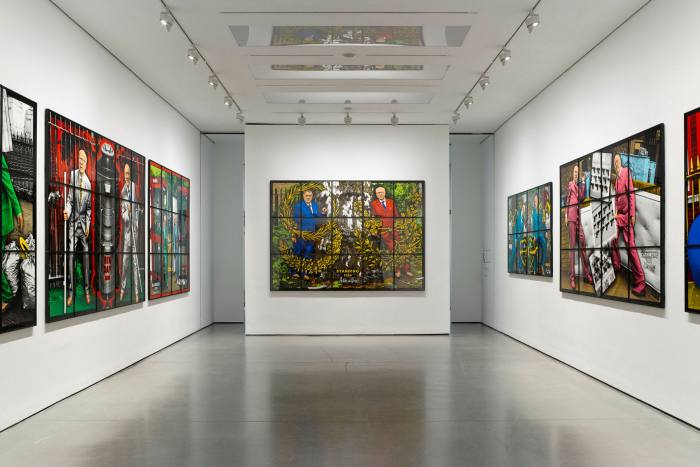Gilbert & George: ‘All the museums now are woke’ Josh Spero meets with the artist-duo
By Josh Spero
I had expected, walking into the east London studio of artists Gilbert and George, something like a cathedral. After all, their work over the past five decades has repurposed the bright medieval aesthetics of stained-glass windows for photo-collages of modern urban life, their icons everything from skinheads and bus shelters to sex workers and shit. (...)
We are meeting to discuss a moment of their career which is slightly closer to Space Invaders than the medieval era: Gilbert and George featured in the 1982 edition of prestigious five-yearly art show documenta in Kassel, Germany, and the Thaddaeus Ropac gallery will be showing works by them and other artists from documenta 7 at Frieze Masters next week. In “Street Meet” (1982), a green young man poses a little like Saint Sebastian in front of a black and white urban scene, while a yellow Gilbert and George stand stiffly like visitors from another planet. (...)
They don’t hold with much of the art world’s politics, as becomes clear when I ask about the gallery they are setting-up off nearby Brick Lane to show their work (“the World of Gilbert & George”, as they call it) in perpetuity. Are they doing it because they don’t think other galleries, such as Tate, will convey posterity on them?
Gilbert says: “They have 23 [of our] pieces that they never show . . . All the museums now are woke.” Woke? “Yes.” And you’re not woke? George: “We were woke before woke.” Gilbert: “No, we don’t know what it is, we are normal.” (...)
Perhaps it is precisely that their local universe consumes their whole vision. As our conversation winds down, Gilbert and George show me ink signs they have made to be sold in aid of the Serpentine Gallery — NO WAY. KISS ME. FUCK ’EM ALL (“Our general approach to life”, says George) — and show me out through their impeccably restored 18th-century house. I ask to take a photo of them so I can remember what they are wearing; they oblige, standing a little uneasily at the threshold, and it strikes me that, in many ways, the world of Gilbert and George goes not much further than their doorstep.

















































































































































































